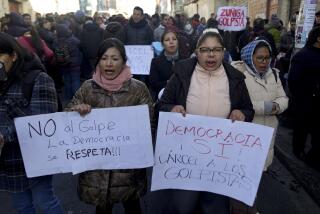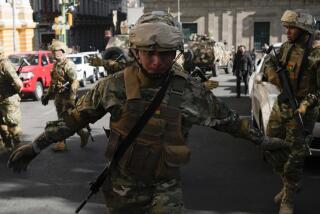Coup Launched Against Aquino : Philippines: Rebel planes bomb presidential palace in support of revolt by troops. Two military garrisons are taken over, airport is closed.
- Share via
MANILA — Rebel planes bombed President Corazon Aquino’s presidential palace in Manila Friday in support of a coup attempt by troops who took over at least two military camps and closed the international airport.
Grabbing the initiative less than three hours after Aquino went on state television and vowed to crush the coup attempt, rebel pilots in World War II-style single-engine planes made at least three bombing runs over Malacanang Palace.
They also attacked government troops trying to penetrate the government television station, which had been taken over earlier by the rebels, witnesses said.
Gen. Renato de Villa, military chief of staff, said rebels had seized Villamor Air Base, headquarters of the Philippine air force; the headquarters at Ft. Bonifacio; the government broadcast center; a private television station; and the Ninoy Aquino International Airport. The airport was reported closed to all flights.
Defense Minister Fidel V. Ramos said on Manila radio earlier he would bring up an “overwhelming force” to crush the revolt involving about 1,000 troops. The revolt has been linked to a dismissed colonel, Gregorio (Gringo) Honasan, leader of a violent army mutiny against Aquino on Aug. 28, 1987, in which 53 people were killed.
Honasan escaped from prison last year and remains at large. He gave clandestine interviews about a week ago threatening a move against Aquino.
The United States voiced strong support for Aquino, who restored democracy in the Philippines after 20 years of authoritarian rule by the late Ferdinand E. Marcos ended in a coup in February, 1986.
Washington warned all aid would be suspended if Aquino was removed in a coup. She has defeated five previous coup attempts.
“We reiterate the unequivocal support of the U.S. government for Philippine democracy and the government of President Corazon Aquino. We strongly condemn the effort to destabilize the elected Philippine government,” White House press secretary Marlin Fitzwater said in a statement.
He added that, “according to U.S. law, all U.S. foreign assistance to the Philippines would be suspended if the elected government of the Philippines were removed by a military coup.”
As three T-28 aircraft bombed and rocketed the compound of Malacanang Palace, presidential guards responded with small arms fire. “They’re bombing us!” a palace staff member cried over the telephone. “We’re going down!”
Lourdes Sytangco, deputy presidential spokeswoman, said Aquino was safe. Sytangco said she could not give a damage report because no one could leave the building.
No official casualty figures were available more than eight hours after the insurrection began. But witnesses and reporters said at least 10 people were killed and 10 wounded.
“An attempt to seize power by force is again being made,” Aquino said in a nationally televised address. “Our forces have the situation under control. We shall smash this shameless and naked attempt once more.
“This nation must never be allowed to fall unto the hand of tyrants. Those who wish to be kings are here once more, despite repeated rejections by the people.”
Cardinal Jaime Sin, Roman Catholic archbishop of Manila, urged his countrymen “to support the duly constituted authority.”
Defense Secretary Ramos said the rebellion began shortly after midnight when about 200 marines tried to enter Villamor. About two hours later, air force troops who had been guarding the gate left their posts and mutinous marines took over security at the base perimeter.
Rebels fired heavy weapons at the headquarters of the 205th Helicopter Wing, setting fire to the building.
A marine captain, who refused to give his name, said about 2,000 troops were involved in the mutiny.
Truckloads of mutineers, wearing white arm bands and carrying red flags, entered the government radio and television station and the adjacent private station ABS-CBN. The significance of the red and white colors was not clear.
Mutineers at the government television station cheered and shouted: “Cory is dead! Cory is dead!” when they saw the attack on the palace.
Rudolfo Aguinaldo, governor of Cagayan province and a former lieutenant colonel, said in a radio interview that soldiers in his northern Luzon area supported the mutiny and “we are bringing in artillery and armor.”
Emmanuel Palaez, Philippine ambassador in Washington, said Aquino told him by telephone before the air attack “the armed forces had already made some arrests and that all the chiefs of the armed services had reported to her.”
Reinforcements took up positions during the night around Aquino’s residence and her office at nearby Malacanang Palace. Tanks and trucks blocked the main street that runs past the palace.
The U.S. military increased security at its six military bases here. But the bases, containing 40,000 troops, military dependents and Defense Department civilians, are more than 50 miles from Manila and somewhat removed from the action. Up to 100,000 other U.S. civilians also are in the Philippines.
De Villa told reporters late Wednesday that a coup attempt appeared to be planned for Thursday, “and for this reason I have placed all units in the affected areas in full alert status.”
He said the plot was discovered after 13 members of the army’s elite Scout Rangers sabotaged two communications transmitters 30 miles south of Manila late Wednesday.
Col. Jesus Ranjo, chief of staff of the National Capital Region Defense Command, said all 13 were in custody and three other officers were being sought.
Rumors of a new coup attempt swept Manila last month after a dispute over plans to reorganize the Philippine Constabulary.
Congress is considering a proposal to abolish the Constabulary, a branch of the armed forces, and replace it with a civilian-controlled national police.
Constabulary troops have staged protests in Manila and Cebu against the reorganization plan.
Honasan’s coup attempt in August 1987 was the bloodiest and most dangerous of the half-dozen revolts against Aquino. The colonel played a key role in the military mutiny that started the uprising against Marcos, who died in exile in Hawaii on Sept. 28.
He became disenchanted with Aquino, however, accusing her of failing to crush Communist rebels and rid the government of corruption.
He was arrested in December 1987, but escaped from a prison ship in Manila Bay the next April.
Staff writer Jim Mann in Washington and Dolly Amor, The Times’ office assistant in Manila, contributed to this story.
More to Read
Sign up for Essential California
The most important California stories and recommendations in your inbox every morning.
You may occasionally receive promotional content from the Los Angeles Times.













